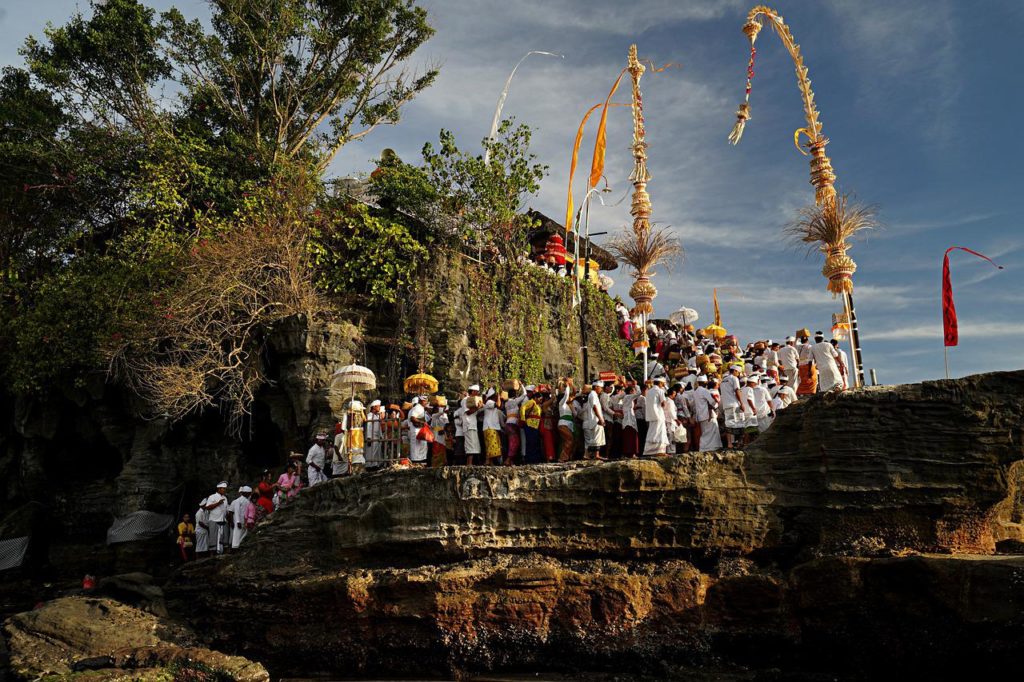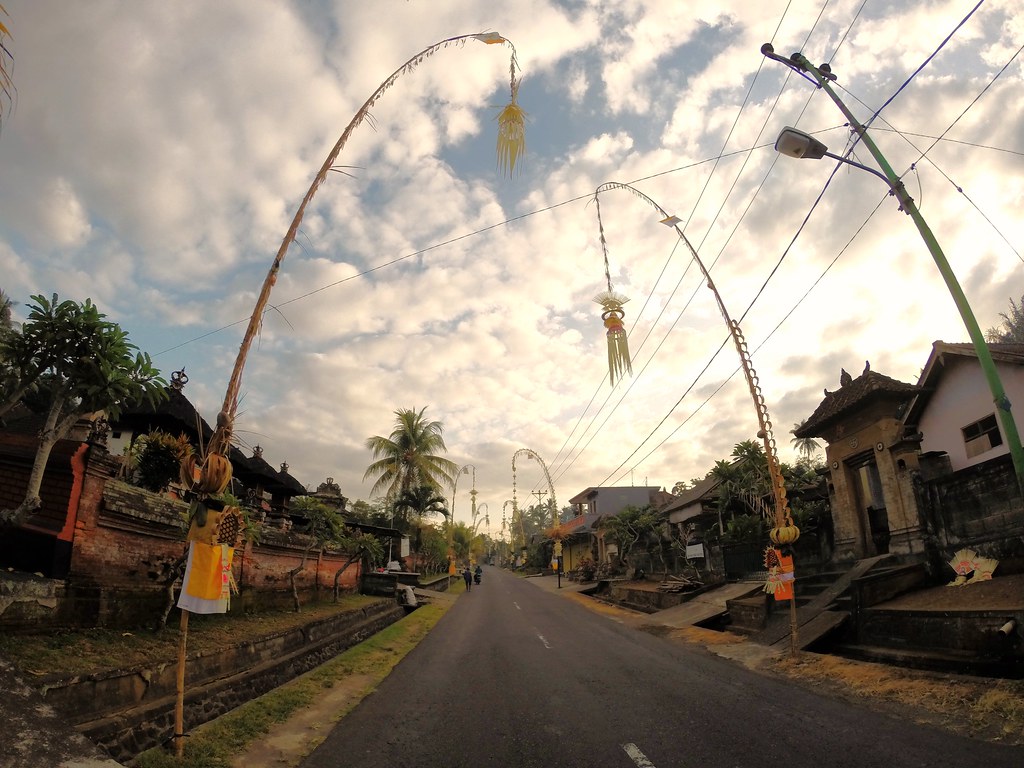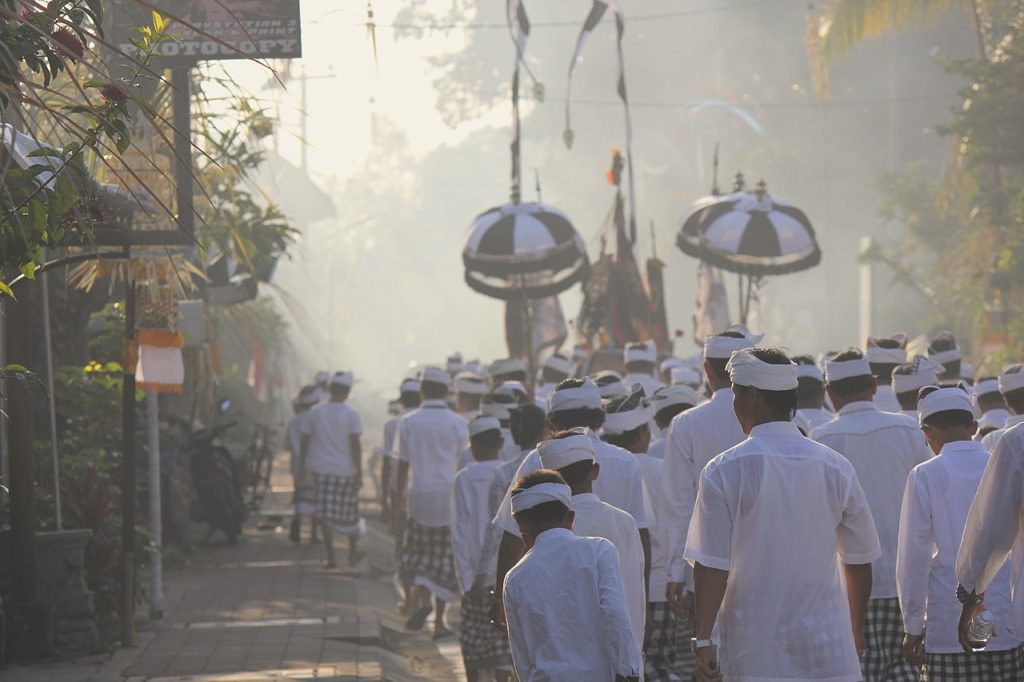The Galungan Festival symbolizes the victory of Dharma (Virtue) upon Adharma (Evil), filled with cultural rites and ceremonies.
Galungan in Bali honours the God of creation – Ida Sang Hyang Widi. The festival is believed to be a celebration of the triumph of good against evil or dharma against adharma according to the Hindu religion. According to local legends, the festival is to mark the defeat of the Balinese king Mayadenawa. The king, extremely powerful and undefeatable, did not let his subjects embrace or follow Hinduism. Finally, the Lord Indra defeated him in the bloody battle at Tampaksiring, Gianyar. This victory day is celebrated every six months (6×35 days=210 days), which is called Galungan Day.
 The Galungan Festival is held in Bali. Galungan Day signifies “Pawedalan Jagat” or the earth’s festival ceremony. On the eve of Galungan Festival the Hindus thank God for his creations on earth and its content. On this day the Hindus express their gratitude to God and invite him to come down to earth and join in their celebrations.
The Galungan Festival is held in Bali. Galungan Day signifies “Pawedalan Jagat” or the earth’s festival ceremony. On the eve of Galungan Festival the Hindus thank God for his creations on earth and its content. On this day the Hindus express their gratitude to God and invite him to come down to earth and join in their celebrations.
 Different days mark different rounds of celebrations and unique festivities of Galungan in Bali, lasting for around 10 days. Three days before Galungan, on the Penyekeban day – bananas are prepared as offerings to the Gods. Penyekeban literally translates to mean ‘the day to cover’, as the Balinese cover green bananas in clay pots to ripen them fast. The next day, the Penyejaan -fried rice cakes or jaja are made as offerings. The day before the festival, the Penampahan – chickens and pigs are slaughtered to prepare a huge feast. Some of the traditional food prepared on this day include satay and lawar – a pork preparation.
Different days mark different rounds of celebrations and unique festivities of Galungan in Bali, lasting for around 10 days. Three days before Galungan, on the Penyekeban day – bananas are prepared as offerings to the Gods. Penyekeban literally translates to mean ‘the day to cover’, as the Balinese cover green bananas in clay pots to ripen them fast. The next day, the Penyejaan -fried rice cakes or jaja are made as offerings. The day before the festival, the Penampahan – chickens and pigs are slaughtered to prepare a huge feast. Some of the traditional food prepared on this day include satay and lawar – a pork preparation.
One of the essential commodities for Galungan Festival is Penjor. Penjor is made of a long bamboo pole with its curved end, and decorated with rice paddies, corn on the cob, coconut, cakes, a piece of white or yellow cloth, etc. Penjor is usually built on Penampahan Galungan (a day before the Galungan Day). It is symbolizes Mount Agung and gratitude for the agricultural produce.
 There are many temple festivities planned, like the Kuningan celebrations at the Sakenan Temple. Offerings of flowers and foods are carried to the temple by both men and women folk. Many dance performances and rituals run throughout the days. Galungan day and the next day is usually spent with visiting family and relatives. During Galungan, a popular ceremony is the Ngelawang, or an exorcism. It is carried out a barong, who goes from house to house and is made offerings of money, to rid the house of any evil and restore the good.
There are many temple festivities planned, like the Kuningan celebrations at the Sakenan Temple. Offerings of flowers and foods are carried to the temple by both men and women folk. Many dance performances and rituals run throughout the days. Galungan day and the next day is usually spent with visiting family and relatives. During Galungan, a popular ceremony is the Ngelawang, or an exorcism. It is carried out a barong, who goes from house to house and is made offerings of money, to rid the house of any evil and restore the good.
It is believed that the spirits of ancestors descend upon Bali during the Galungan festival, and the locals organise a variety of offering and rituals during the course of the festival to honour these spirits. The Kuningan observed 10 days after Galungan Day, is the day on which it is believed that the spirits of the ancestors who had come down from for the celebrations, would return back to their holy abodes. The Balinese people prepare special offerings of yellow rice on this day.
According to holidify.com AND indonesiaairport.com














